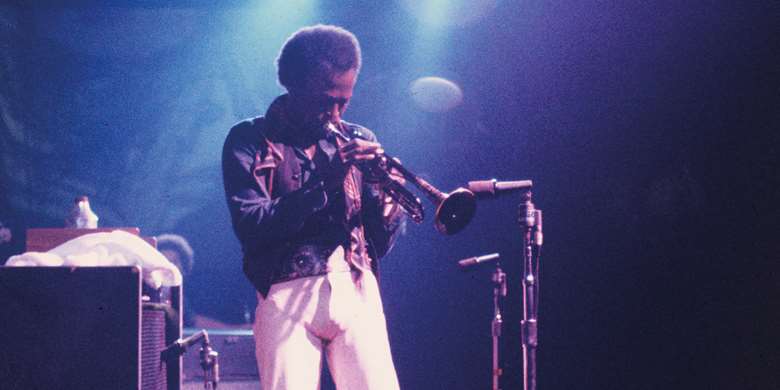Review: Miles Davis biopic, Birth of the Cool
Monday, February 10, 2020
Selwyn Harris assesses Birth of the Cool, the latest big-screen attempt to capture the myth of Miles Davis on film

Putting together a comprehensive document of Miles Davis on film is no small undertaking. A huge slice of jazz history can be uncovered in his musical works alone and as a personality, as well as artist, he was never less than complex, teeming with contradictions. The last effort that covered quite a few of those bases was Mike Dibb’s very watchable TV movie The Miles Davis Story, released in 2002. There are others that lightened the load by discussing just one aspect or epoch, 2004’s Miles Electric: A Different Kind of Blue being one of the better ones. Few have attempted to create something as boldly imaginative as the iconic trumpeter himself. Credit to Don Cheadle in that respect for his biopic feature Miles Ahead (2015), even if it was an uneasy freewheeling fusion of fact and fantasy.
Now, from the 68-year-old Emmy-award winning New York filmmaker Stanley Nelson, comes a fairly high-profile cinema release, Birth of the Cool. By sticking to objective facts and recollection voiced by a diverse pool of contributors, Nelson makes a thorough examination of the overlap between Miles’ life and work. It’s the talking heads that drive the narrative alongside a voiceover by actor Carl Lumley quoting from Miles’ autobiography; convincingly delivered, even without the widely-imitated rasp. Unexpectedly, it turns out a pretty shrewd move. Miles’ self-awareness and reflective tone counterpoints well the observations and anecdotes of the various interviewees.
Coming in at just under two hours, the film is bog-standard cradle-to-grave format, visually stimulating only in so far as Nelson had access to an exhaustive range of archival pics and reels. But the director’s attention to detail on the significance of Miles’ musical innovations goes way beyond other mainstream legendary biopics where the norm is to highlight the sensationalist, headline-grabbing stuff – not that we don’t get a ‘warts and all’ portrait (there’s plenty of that with Miles, of course). That also makes it an admirably risky venture in terms of audience reach.
If there is an angle that distinguishes this film from its predecessors, it’s shaped by Nelson’s specialism in his previous filmography on African-American experience and history. He confirmed as much in a panel discussion following an October screening in London: “This is more than a film about Miles. It’s about what it’s like to be a black man in the US.” Throughout, Nelson enquires into the trumpeter’s intense pride in his racial identity and the big impact this had on his work and audiences. Friend and saxophonist Jimmy Heath describes the highly successful period following Kind of Blue as being, “the black man’s era when he wanted to show his pride and Miles was exhibit A”. Earlier on, the African-American literature writer Farah Griffin had suggested – commenting on the possibilities opening up for him following his stay in Paris during the World War II years – that there was also, “a sense that one can be fully oneself beyond the boundaries of race, that it isn’t something to hold you back.”
This is more than a film about Miles. It’s about what it’s like to be a black man in the US
Stanley Nelson (Director of Birth of the Cool)The film opens with grainy never-seen-before 1970s 16mm footage of Miles shadowboxing in the ring. It was shot by Corky McCoy, who’s known for his illustrations on the record sleeve of On the Corner, among others. It’s hauntingly revisited during the movie as a symbol of Miles’ defiant artistry, but also his well-documented physical abuse towards his wives and girlfriends. We pass chronologically from his privileged background in St Louis, where, it is said, “his wealth wouldn’t have protected him from segregation”, to a fledgling career with Billy Eckstein to 52nd Street and a Juilliard education, with an attitude revisited throughout the film: “I wanted to see what was going on in all music,” proclaims the voiceover.
Though Miles’ electric period through to his dark sabbatical from 1975-80 (the period covered by the film Miles Ahead) to his rebirth in the 1980s isn’t covered in as much detail as the earlier half of his career, Nelson makes a fair point when he says, “we covered all areas and made sure we talked about later stuff that people sometimes pass over.”
Then there’s the huge impact of the women in his life: Frances Taylor, a gregarious, engaging contributor who gave up a promising dancing/acting career on Miles’ orders. She passed away in 2018, regrettably before seeing the film. The singer Betty Davis (née Mabry), the crucial catalyst for his radical early 1970s shift in music style and look, and Cicely Tyson, not featured, who oversaw his rehabilitation into the 1980s. Indeed, as the film demonstrates, salvation in his life often came from the people around him: his father’s tough love when kicking the heroin habit, through to benevolent collaborators such as Gil Evans and promotor George Wein.
In the unforgiving age in which we live, when details of a public figure’s private life can serve to condemn his art even in retrospect, Nelson does well to give equal weight and perspective to both, capturing the many sides to Miles and letting us make up our own mind about him. As cinema it’s highly conventional and unimaginative, the polar opposite of its subject. But on the musical side and on concepts of racial identity it delves a bit deeper into Miles than anything previously portrayed onscreen.
This article originally appeared in the December 2019 / January 2020 issue of Jazzwise. Never miss an issue – subscribe today!




